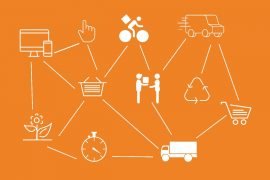Practice makes perfect and, sometimes, the right road to take is the less travelled. However, it can be useful to keep an eye on where everyone’s going and then decide which direction to take. In this respect, the communication of businesses in the new economy shows a few interesting specificities compiled in the following decalogue:
1. 360-degree view
Communication actions are planned and coordinated from an integral outlook that takes into consideration all audiences and channels of communication. Regardless of who with, how and through which channel we communicate, businesses, their brands and people convey basically the same messages. Making the most of synergies maximizes the return on the investment and improves coherence.
2. Decision-making based on hard data
The big data generated by one’s platforms allows prior research from native digital businesses, as well as monitoring and evaluation of communication strategies. The goals of communication are established on the basis of key performance indicators (kpi), that is, indicators monitored almost in real-time.
3. Constant learning
Knowledge is the most valuable asset of the new economy. The speed at which society advances requires from communication professionals to become knowmads, consisting in a positive attitude of constant learning. Success comes after trial, data analysis and considering errors as an opportunity for improvement.
4. Clear and concise message
Communication in the new economy does not drift. Nowadays we live and decide at a fast pace, we live in a world where 140 characters speak louder than one thousand words. As a result of this, the start-up ecosystem incorporates commonly-used practices such as an elevator pitch, that is, transmitting our business idea in an extremely short and pithy version, as if it were to be delivered during an elevator ride.
5. Growth as a goal
The figure of the growth hacker is the most coveted in the digital ecosystem. According to the term’s creator, Sean Ellis, the author of the Startup Marketing Blog, the term applies to someone who is sufficiently creative to foster growth.
6. Team work
In the new economy, the teams are multidisciplinary and have flexible horizontal and non-hierarchical structures. Therefore, the communication strategies can be designed and executed in a coordinated and integrated manner, and make the most of synergies created through collaborative work.
7. User empowerment
Users are the main asset of today’s new economy. A user who becomes a brand’s ambassador is the best possible consumer incentive. To this end, it is necessary to establish conversation with him, engage him into our project and empower him. For instance, campaigns such as #Wallacar, the geolocalized Wallapop marketplace, became popularized through participation of its users in a contest from social networks.
8. Content is king
“Content is King”, predicted Bill Gates over two decades ago. “Content marketing” is a communication technique commonly used by brands in the new economy, and they count on specialized teams working on this area with a view to gathering valuable information and entertainment for their target customers. Westwing, for example, an online platform that provides services and products related to interior designing, has the appearance of a magazine, instead of e-commerce, and generates contents such as videos like #40preguntasmuyWestwing.
9. Yes to influencers
Organic positioning is gradually getting more complicated and is time-consuming (and investing in content is expensive) to achieve followers and reputation. Alliances with influencers are a useful and highly recommended communication strategy, as long as the specifiers are adequate and enable win-win relationships. The real estate portal Fotocasa, for example, has implemented influencer marketing techniques of all types, from collaboration of experts on sectorial reports -e.g. elaboration and dissemination of the book Tendencias del mercado de alquiler [Trends of the renting market]-, to parties promoted by social networks through celebrities like #Fotocasaparty.
10. Analogic (still) works
The integrated outlook between the on and offline world, which defines the digital natives, allows them to design their media plan efficiently. In this respect, the mass media, e.g. tv, radio, written press and, even, outdoor advertising, still play an important role, in tandem with the growing influence of the digital world.
This decalogue has been designed on the basis of an exploratory study developed fully in my doctoral thesis “Estrategias de comunicación en la nueva economía: publicidad y relaciones públicas en la era digital” [Communication strategies in the new economy: advertising and PR in the digital age], directed by Professor Josep Lluís Micó, Vice-Dean of the Facultad de Comunicación y Relaciones Institucionales Blanquerna of the Universitat Ramon Llull, with the collaboration of 4YFN-Mobile World Congress, Wallapop, Westwing and Fotocasa.




















